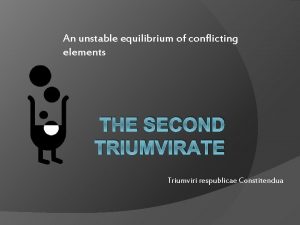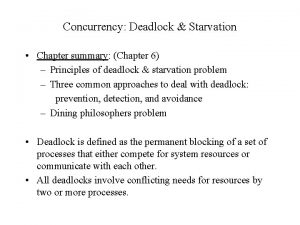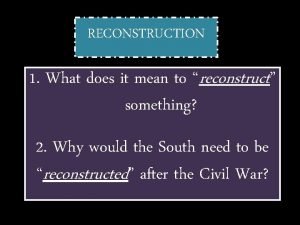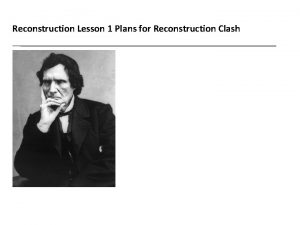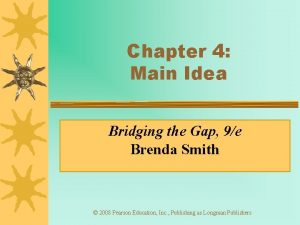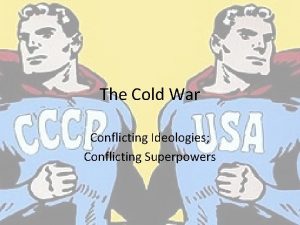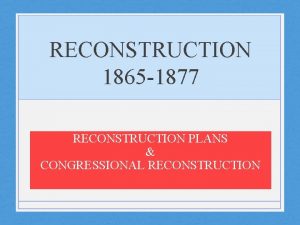Reconstruction The Main Idea Conflicting plans for dealing


























- Slides: 26

Reconstruction The Main Idea Conflicting plans for dealing with the post-Civil War South had longlasting effects on government and the economy. Reading Focus • What were the differing plans for presidential Reconstruction? • What was congressional Reconstruction? • What happened when Radical Republicans took charge of Reconstruction? • Why did Reconstruction end, and what were its effects on American history?

Presidential Reconstruction Lincoln’s Plan • In late 1863 Lincoln issued a Proclamation of Amnesty and Reconstruction, offering forgiveness to all southerners who pledged loyalty to the Union and supported emancipation. • Lincoln’s Ten-Percent Plan stated that once 10 percent of a southern state’s voters took the oath, they could organize a new state government, which had to ban slavery. Lincoln’s Plan Sparks Debate in Congress • Some Congress members thought re-admitting states to the Union was only a power of Congress; some thought the South never officially left the union. • Others thought southern states should go through the same admission process for statehood as territories. Congress Responds, Tragedy Strikes • Congress’ own plan, the Wade-Davis Bill, required a majority of a state’s white men to pledge the oath, not just 10 percent. It was vetoed by Lincoln. • Lincoln was assassinated by John Wilkes Booth in 1865, and didn’t live long enough to carry out his Reconstruction plans for the South.

Johnson’s Plan • After Lincoln’s death, Vice President Andrew Johnson became president. • Though he was a Democrat, Republicans thought he would work with them because he didn’t seem as forgiving as Lincoln. • As a Tennessean from a poor family, Johnson didn’t dislike the South, just wealthy planters. • Johnson’s plan was similar to Lincoln’s, with a few changes. The Reconstruction Plan: • Added wealthy southern men to the list of those who needed to be pardoned by government • Did not, according to Charles Sumner, Thaddeus Stevens, and other powerful members in Congress, provide any role in government for freedmen, or those freed from slavery • Was welcomed by white southerners, who could form state governments on their own terms Reactions in the South: • Former Confederates took state offices and were sent to Congress. • The Black Codes were formed, keeping freedmen in a dependent position and providing cheap farm labor. • Private groups formed like the Ku Klux Klan, who enforced the Black Codes and terrorized African Americans and their supporters.

Congress Takes Control • Most northerners supported Johnson’s plan, until the Black Codes and the return of former Confederates to power upset them. • That strengthened Radical Republicans, who wanted a stronger Reconstruction program to reshape southern society politically and economically, and to help freedmen gain equality. • After Congress reconvened in 1866, moderate Republicans, who controlled both the House and the Senate, proposed two bills. The first supported the Freedmen’s Bureau, an organization Congress created in 1865 to help former slaves and poor whites in the South. It allowed the bureau to build more schools and provide other aid. The second bill was the Civil Rights Act of 1866, which gave African Americans citizenship and guaranteed them the same legal rights as white Americans. Both bills passed in Congress, but Johnson’s veto led moderate Republicans to help Radical Republicans take over Reconstruction.

Radical Reconstruction • To protect the Civil Rights Act of 1866, Congress passed the Fourteenth Amendment, requiring states to grant citizenship to everyone born or naturalized in the United States and promising “equal protection of the laws. ” • In the 1866 congressional elections, Radicals gained enough votes to take over Reconstruction, and passed four Reconstruction Acts • The acts set three conditions for readmission. – Ratify the Fourteenth Amendment – Write new state constitutions that guaranteed freedmen the right to vote – Form new governments to be elected by all male citizens • Congress also passed the Tenure of Office Act in 1867, requiring the Senate’s permission to remove any official it appointed. • When Johnson tested the act by firing Secretary of War Edwin Stanton, who supported Radical Republicans, the House voted to impeach him. • The Senate lacked one vote for the two-thirds majority they needed to remove Johnson from office.

Republicans in Charge • Republicans chose Civil War war hero Ulysses S. Grant as their candidate in the 1868 presidential election. • About half a million African American votes gave Grant the victory. • Congress passed the Fifteenth Amendment, protecting African American male voting rights. • As Congress took control of Reconstruction, discrimination slowed and the Black Codes were repealed. • White southerners who supported Reconstruction were called scalawags, or scoundrels, by ex-Confederates. • This varied group included farmers who wanted the wealthy class’s power, those ruined by the war, and business leaders who wanted to stop the South’s dependence on agriculture. • Northerners who came south to join in the region’s rebirth were called carpetbaggers. • They also came from varied backgrounds, including politicians, teachers, Freedmen’s Bureau officers and former soldiers. • Some were African Americans.

Freedom Brings Changes • Freedom meant African Americans could search for long-lost relatives, own land, and have jobs of their choice. • Many freedmen moved to urban areas, mainly in the South, but were met with prejudice and low pay. • Some went West, becoming business owners, miners, soldiers, or cowboys. • Freed slaves eagerly sought education. The Freedmen’s Bureau started more than 4, 000 schools. • African Americans also established churches, created trade associations, fire companies, employment agencies, and mutual aid societies.

Economic Changes • For many freedmen, owning land meant freedom, but even those with money found landowners unwilling to sell to them and give them economic independence. • A new labor system gradually arose. Sharecroppers received a share of their employers’ crops. The employer provided land, shelter, seeds, animals, and tools. The sharecropper provided labor. • Tenant farmers rented their land from landowners and could grow any crop. Many grew food crops, not cotton, to provide both food and income. It was hard for tenant farmers and sharecroppers to rise out of poverty. • While the rural South suffered economic hardship, southern cities grew rapidly as railroads linked North and South. • Southern business leaders and northern investors joined to build mills and other ventures, but this did not help freedmen or poor southerners.


Reconstruction Ends Violence Discontent • Violence plagued the South during Reconstruction. • Eventually, most people were unhappy with Reconstruction. • The KKK and similar groups terrorized minorities. • The army still had to keep the peace in the South, and the Republican government seemed ineffective. • Terrorists targeted African American leaders and people of both races with burnings and violence. • They beat Freedmen’s Bureau teachers and murdered public officials, many of whom resigned. • When state governments couldn’t control violence, Congress passed Enforcement Acts that set penalties for trying to prevent a qualified citizen from voting. • The Acts also gave the army and federal courts the power to punish Klan members. • African Americans were unhappy about their poverty and lack of land reform and all were discouraged by the South’s poor economy. • Some said Reconstruction governments were corrupt. • These conditions strengthened the Liberal Republicans, who broke party and helped Democrats win back Congress in 1872.

The Impact of Reconstruction • By the mid-1870 s it was clear that Reconstruction was ending. • Its fiercest leaders, Thaddeus Stevens and Charles Sumner, had died. • Supreme Court decisions, such as the Slaughterhouse Cases, in which the Court said that most civil rights were under state control and not protected by the Fourteenth Amendment, weakened its protections. • As support for Reconstruction declined, southern Democratic leaders and supporters grew bolder. • Lawlessness and violence against Republican candidates increased, and some were murdered. • When Mississippi’s governor asked Ulysses S. Grant for help in 1875, he refused. • In the 1876 presidential election, Rutherford B. Hayes was given the presidency when Republicans promised to withdraw federal troops from the South, causing the collapse of Republican state governments. • Some called the post-Reconstruction South “the New South. ”


The American West The Main Idea As Native Americans gradually lost their battle for their lands in the West, settlers brought in new enterprises—mining, ranching, and farming. Reading Focus • How did changing government policies lead to conflicts with Native Americans in the West? • How did mining and ranching influence the development of the West? • What opportunities and challenges did farmers face on the Great Plains?

Conflicts with Native Americans • By the 1890 s, Native American cultures were dying, and many turned to a prophet, Wavoka, who said that through a Ghost Dance a messiah would save them. • White settlers streamed into the lands of the Sioux, Cheyenne, Blackfoot, Kiowa, and Comanche, who were known as the Plains Indians. • The Plains Indians did not settle in towns and did not think land should be bought or sold, while white settlers thought it should be divided up into claims. • In the mid-1800 s, the U. S. government’s Indian policy changed: they seized Native American their lands and created reservations for them to live in. • Being confined to these reservations threatened the buffalo-centered Native Americans’ way of life. The buffalo were being driven to extinction by white settlers. • Tensions between Plains Indians and settlers led to a long period of violence known as the Indian Wars.

Events of the Indian Wars Sand Creek Massacre • 1864: The Army persuaded a group of Cheyenne to stop raiding farms and return to their Colorado reservation. • Then army troops attacked, killing about 150 people, and burned the camp. • Congress condemned the actions but did not punish the commander. Battle of the Little Bighorn • The Sioux responded to government relocation by joining other tribes near the Little Bighorn River. • Led by Sitting Bull, they slaughtered General Armstrong Custer’s smaller U. S. force. Wounded Knee Massacre • Army troops captured Sitting Bull’s followers and took them to a camp at Wounded Knee Creek. • Fighting began, and the soldiers slaughtered 300 Native American men, women, and children. • The massacre shocked Americans and broke Native American resistance.

Resistance Fades into Reservation Life • In 1877, while the Nez Percé were relocated to a smaller reservation in Idaho, some killed white settlers on the way, they fled with their leader, Chief Joseph, to Canada where they were captured. • In the Southwest, the Apache were moved to a reservation in Arizona, but their leader, Geronimo, fled the reservation and led raids on the Arizona-Mexico border for years, until they were captured in 1886. • In creating the reservations, the U. S. wanted to Americanize the Native Americans, or make them abandon their traditional culture in favor of white American culture. • The Bureau of Indian Affairs managed reservations, set up public schools often far from children’s homes, and forced them to speak English. • The Dawes Act (1887) broke up some reservations and divided the land for people, but the best land was usually sold to white settlers.


Mining Culture After the California gold rush, each new strike inspired more settlers westward in hopes of finding the next Comstock Lode or Klondike River. Mining Communities Mining as a Business • Most miners were men, but some families and single women also came. • At first individual prospectors worked mines with hand tools. • Mining camps were usually just groups of tents and shacks. • When surface deposits ran out, large companies moved in to prospect with machinery. • Some camps grew into towns with stores and businesses. • As more families arrived, churches, schools, and newspapers sprang up. • Some camps grew into major cities such as Denver, Colorado. • At that point, most miners went to work for large companies giving up on striking it rich. • It was dangerous work, and some miners tried to organize unions for better working conditions, but mining companies resisted.

Ranching Culture Ranching on the Plains • After the Civil War, cattle ranching dominated the Plains. • First the Spanish in the 1500 s, then the Mexicans, became skilled at raising cattle in harsh conditions. They interbred Spanish and English cattle to breed Texas Longhorns, which were hearty and thrived on the Plains. • The Spanish also brought sheep ranching to the Plains, which grew after the Civil War when demand for wool expanded. • Sheep farmers cattle owners clashed over grazing land became violent. Cattle Drives • Demand for beef grew in the East, so ranchers hired cowboys, usually white teens, for three–months–long cattle drives to railroad towns for shipping. • The Chisholm Trail from San Antonio to Kansas was a major cattle trail. Ranching as Big Business • The invention of barbed wire helped cattle owners manage large herds. • Between 1882 and 1886 more than 400 cattle corporations sprang up in the West, but fencing led to conflict when land owners who enclosed their land left landless cattle owners with nowhere to graze their cattle.


Farmers on the Great Plains • With encouragement from the government, people started pouring onto the Great Plains to build farms. • In 1862 Congress passed three acts to encourage settlement: The Homestead Act let any head of household over 21 to claim 160 acres of land, as long as they built a home, farmed for five years, and made improvements. The Pacific Railway Act gave millions of acres to railroad companies to build tracks and telegraph lines. The Morrill Act gave the states land to build colleges that taught agriculture and mechanics. This was the first federal government assistance for higher education. • The Oklahoma Land Rush occurred when a lobbyist found 2 million acres of land not assigned to any Native American nation. Despite the government’s ban against settlers’ entry into the Indian Territory, settlers were still able to claim the land. • On April 22, 1889, would-be settlers lined the border until it opened, when 50, 000 people rushed in and claimed homesteads.


The New Settlers White Settlers African American Settlers • Came mainly from states in the • Some left the South because of the Mississippi Valley Black Codes and Ku Klux Klan violence. • Were mostly middle-class farmers or business people • Rumors spread that the federal government would set Kansas aside • Could afford supplies and former slaves, which wasn’t true transportation but brought settlers anyway. European Settlers • Came for economic opportunity • Many Northern Europeans came because they were land-poor. • Irish who came to work on the railroads settled on the Plains. • Mennonite Protestants from Russia brought farming experience. Chinese Settlers • Came for the gold rush and railroads but turned to farming • Helped establish California’s fruit industry • Laws often barred Asians from owning land, so many became farm workers, not owners.

Challenges and Solutions • Farming on the Plains presented challenges because of the harsh climate—bitter cold, wind and snow in the winter, intense heat and drought in the summer. – Many families used wells powered by windmills. – Some settlers learned irrigation from Hispanic and Native American farmers. • Wood for houses was in limited supply. – Settlers used the earth itself to build by digging into the sides of hills or making homes from sod. • Farming was challenging in the hard soil of the Plains. – New machinery like new, sharper-edged plows and combine harvesters helped Plains farmers. – Large companies started giant bonanza farms that were like factories, which profited in good years but were too expensive to survive bad growing years.

Western Migration Ends • In 1890 the U. S. Census Bureau issued a report that declared the frontier closed, because there was no new land left to settle. • In 1893 the historian Frederick Jackson Turner wrote an essay stating that the existence of the frontier gave the U. S. a unique history. • Some causes and effects of Western Migration: Causes • Economic Potential Effects – Opportunity for land gold • Traditional Native American ways of life are destroyed. – Farming, ranching, and rail jobs • Mining communities are established. • Native Americans end resistance – As Native Americans lose battles, they are relocated off valuable land – Government allowed settlers into Indian Territory • Ranches are established, and the cattle industry booms. • Farmers settle on the Plains despite challenges.

 Tells more about the main idea
Tells more about the main idea Example of topic sentence
Example of topic sentence What is the main/ central idea and how do i find it?
What is the main/ central idea and how do i find it? Supporting idea adalah
Supporting idea adalah What's the big idea
What's the big idea Cognitive consumer
Cognitive consumer Conflicting pov
Conflicting pov Conflicting elements
Conflicting elements All deadlocks involve conflicting needs for
All deadlocks involve conflicting needs for Analyzing conflicting information
Analyzing conflicting information Presidential plans for reconstruction
Presidential plans for reconstruction What does reconstruct mean
What does reconstruct mean Korean war vietnam war venn diagram
Korean war vietnam war venn diagram Andrew johnson reconstruction plan
Andrew johnson reconstruction plan Wacana penulisan ipg
Wacana penulisan ipg Expository preaching vs. exegetical preaching
Expository preaching vs. exegetical preaching Commutative property main idea
Commutative property main idea Unstated main idea
Unstated main idea Theme vs main idea
Theme vs main idea Stated main idea
Stated main idea Is thesis statement and main idea the same
Is thesis statement and main idea the same Example of paragraph with topic sentence
Example of paragraph with topic sentence Clareta petacci
Clareta petacci Font like this
Font like this What is the horror genre analyzing the text answers
What is the horror genre analyzing the text answers My dog romeo essay
My dog romeo essay What is topic sentence example
What is topic sentence example







